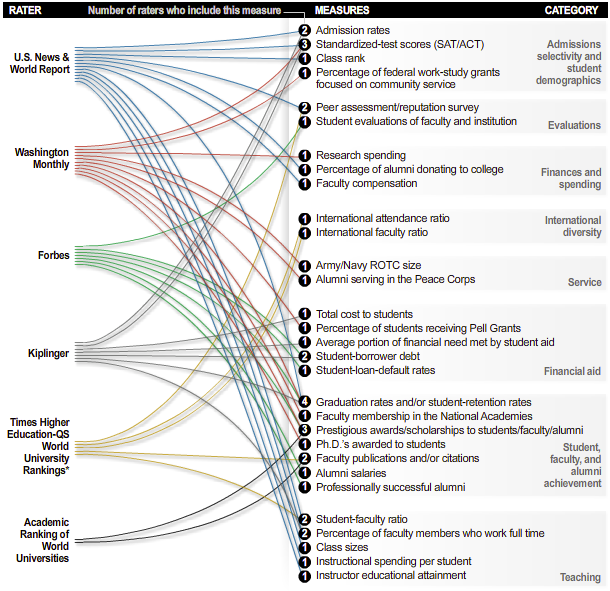There are a bunch of college ratings out there to help students decide what college to apply to (and give something for alumni to gloat about). The tough part is that there doesn’t seem to be any agreement on what makes a good college. Alex Richards and Ron Coddington describe the discrepancies.
Notice how few measures are shared by two or more raters. That indicates a lack of agreement among them on what defines quality. Much of the emphasis is on “input measures” such as student selectivity, faculty-student ratio, and retention of freshmen. Except for graduation rates, almost no “outcome measures,” such as whether a student comes out prepared to succeed in the work force, are used.
This, on top of spotty data across universities, makes rankings, especially for schools that are close in ratings to each other, difficult to know which one to follow. This goes for other types of ratings too. Any headline that starts with “Best states/countries/schools/programs/etc to…” requires some salt since rankings can change dramatically depending on the measures.
But you already knew that, right?
One thing is for sure though. UCLA and Cal stat departments are the best programs to be in. That’s fact.
[Thanks, Ron]



The Parade of Homes, Car Dealers Mall, Rodeo Drive, Avenue of the Stars … Miss America, Congress … can this possibly answer the need to turn out a functioning adult at age 18? Or is this just another smoke, marketing style, and flair?
Let’s study the inane and banal. Let’s cover over the real value, the core of meaningful education. Instead, fill our days with useless detail, frenetic activities, and anticipation of great reward. College has been oversold for many decades, and injured many millions who reshaped their lives into twisted mess.
The college cartel has to answer for this; they’re getting a taste of future wrenching changes, now. Most of these institutions won’t look or function anything like we have known, since the last century.
The rate-a-college display is instructive.
Thank you.
All these ratings are obviously bogus. After all, where are the REALLY important measures, like average attendance at football games, or numbers of NCAA championships in the past decade?
They forgot the alcohol category.
Indeed, I was also thinking that they forgot about a certain publication’s rankings of top party schools. Though I just looked it up and there seems to be an urban legend aspect to it: http://www.snopes.com/college/admin/playboy.asp
While the curvy lines are pretty and all, a standard matrix layout with a circle (or other mark) indicating inclusion of each metric would be easier to read. It takes some effort to figure out which are the four systems that rely on “graduation rates” for example. The excessive intersections of lines make tracing a chore. If there is information on relative weights, these could then be indicated by size of the mark.
As usual, I really enjoy your posts. Kudos for finding this one.
One thing I’d love to see if these major news organizations post international College/University rankings. Obviously if anyone reading is actually serious about putting their kids through college, it makes sense to shop around. I’ve heard that overseas Universities & Colleges these days might actually not only make more financial sense, but also a much bigger bang for your buck in terms of relevance of the education as well as the effectiveness of the teaching.
Will
Pingback: How do ranking systems for universities rate against each? (from Flowing Data) « Irishscience
If you include Cal biostat in your statement regarding Cal stat, then +1. ;)
included!